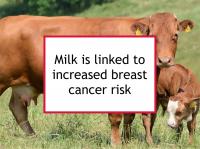Milk has both beneficial and harmful components that could potentially influence breast cancer risk. Calcium, vitamin D, stearate, lactaptin, conjugated linoleic acid (CLA), and bovine lactoferrin each have been found to induce the death of breast cancer cells or to reduce mammary tumor size and number in animals.
In fact, milk has been found to be somewhat protective against breast cancer when consumed in infants and children and has obvious benefits for bone health and strength in them. In addition, low-fat yogurt and kefir both have been linked to reduced breast cancer risk.
However, while not all studies are in agreement, the case for avoiding milk in adulthood is compelling. Most of the milk we drink today is produced from pregnant cows, in which estrogen and progesterone levels are markedly elevated. Components of milk that are suspected to be breast cancer-promoting include saturated fat, recombinant bovine growth hormone (rBGH), insulin-like growth factor (IGF), pesticides, polychlorinated biphenyls (PCBs), and bovine leukemia virus (BLV). Both nonfat and whole milk intakes have been found to increase the incidence and volume of tumors in experimental rats with carcinogen-induced mammary tumors. Numerous retrospective population studies have reported an association between milk consumption and breast cancer risk. Now a major prospective study has reported that dairy milk consumption is associated with increased breast cancer risk, including when any potential risk associated with soy milk consumption is taken into account.
Latest research links milk to increased BC risk
The large prospective study referenced above was designed to investigate the association between dairy milk consumption and breast cancer risk, taking into account the possible contribution of any soy milk intake on risk. The study included 52,795 North American women, with average age 57.1 years, who were cancer-free as of enrollment. A total of 29.7% were African American. A food frequency questionnaire was used to estimate dietary intakes for all study participants. In addition, 1,011 of the participants provided six structured 24-hour dietary recalls. The authors followed the women for 7.9 years, detecting cases of invasive breast cancer primarily by using cancer registries.
A total of 1,057 participants were diagnosed with invasive breast cancer during the study period. When comparing the 90th to the 10th percentile of consumption, high intake of dairy milk was found to be associated with a 50% higher risk of breast cancer. Low-fat and reduced fat milk generated similar results as full-fat milk. High intake of all dairy products combined was associated with a 22% higher risk of breast cancer compared to low intake. The authors did not find important associations for cheese and yogurt. There were no clear-cut links between soy product consumption and breast cancer risk when analyzed independently of dairy intake—including soy milk in the dairy milk analysis did not change the findings.
The authors conclude that high intakes of dairy milk were associated with greater risk of breast cancer, including when adjusted for soy intake, in the study population.
